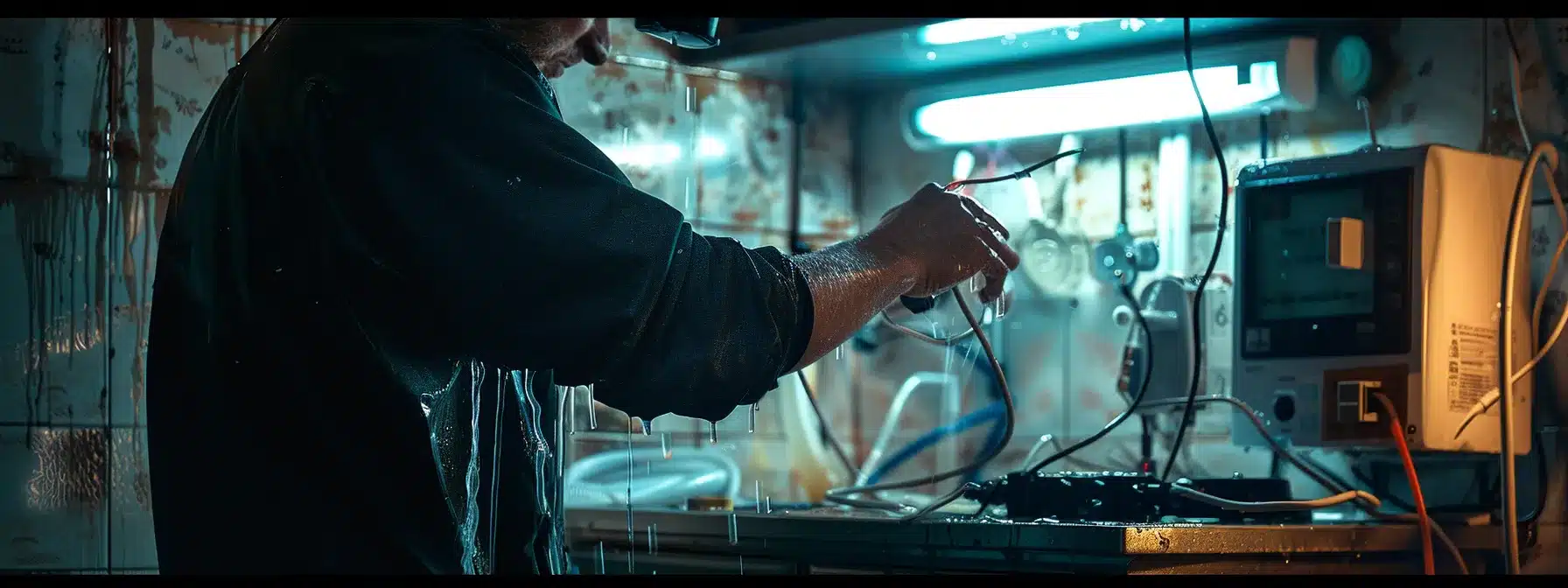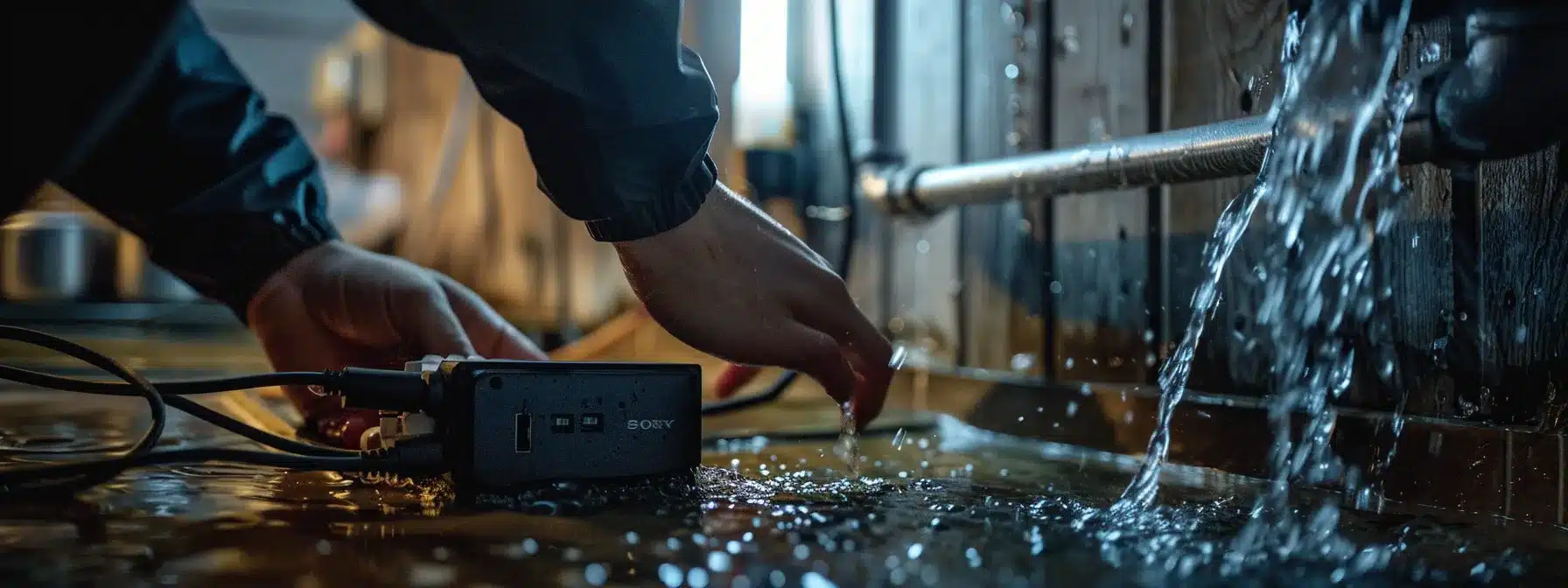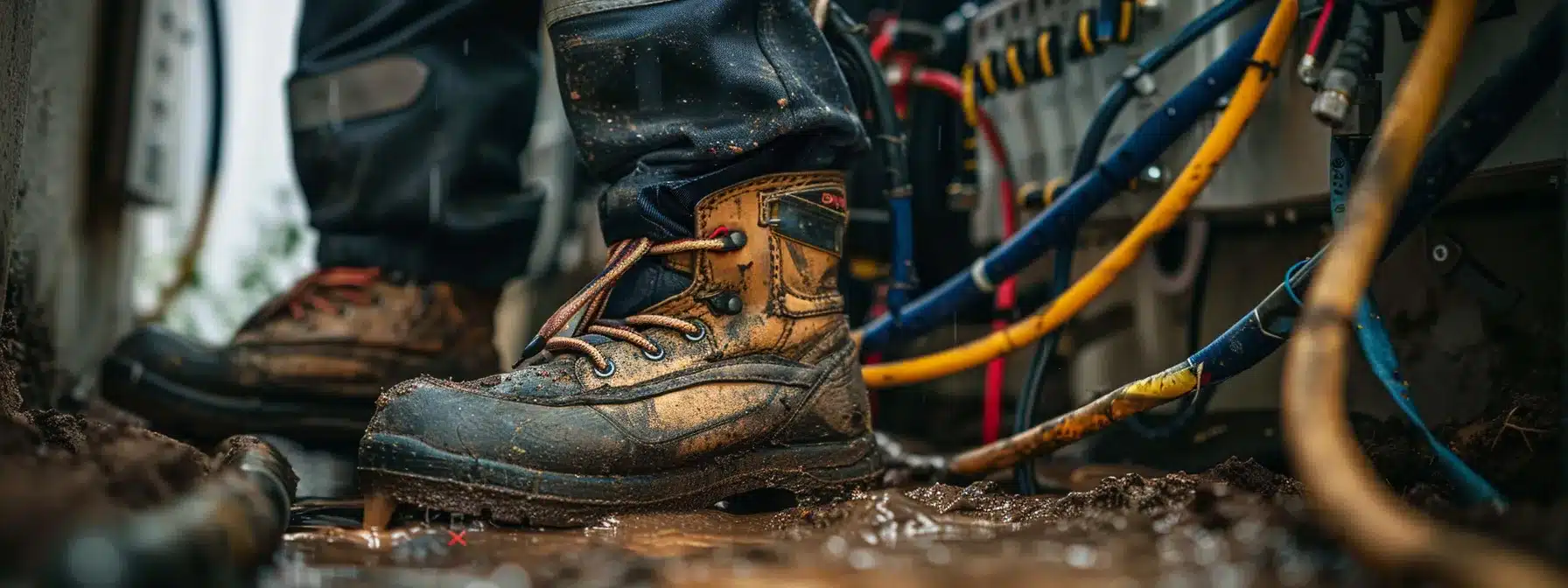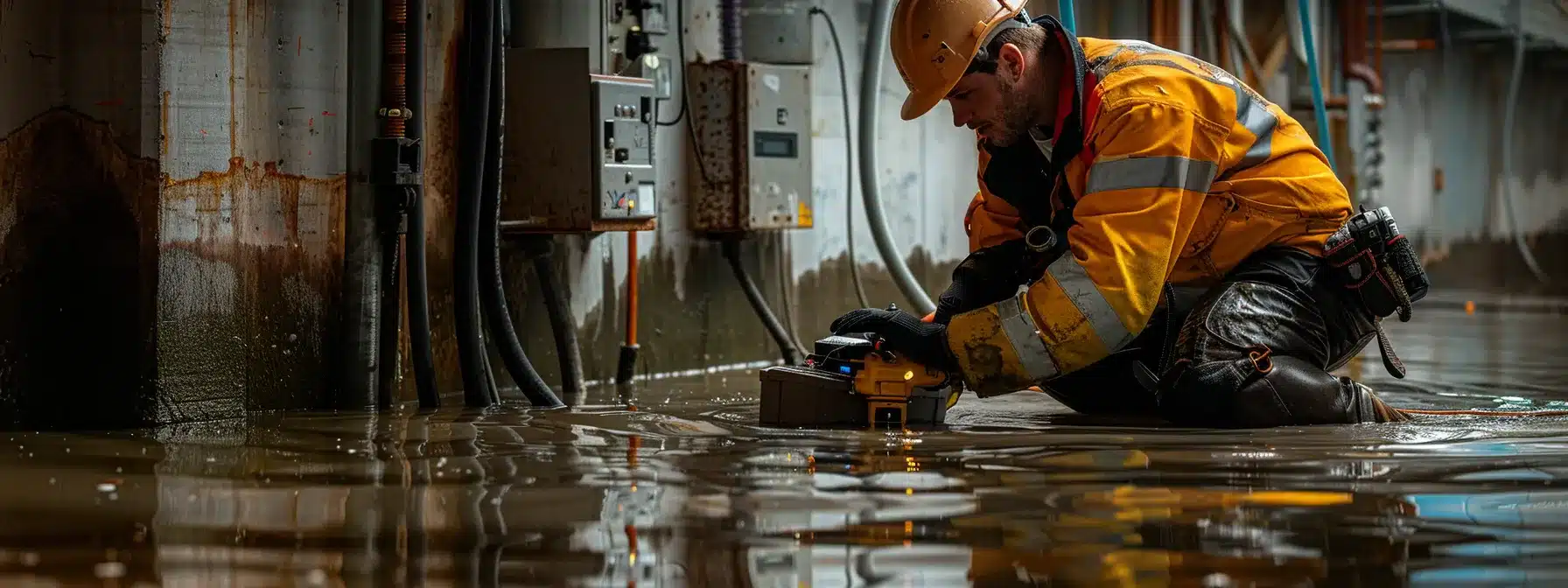Water and electricity create a dangerous combination, especially in areas like the bathroom where a shower mishap could lead to a 120-volt shock. When electrical devices get wet, it’s crucial to prioritize safety and consider calling an emergency electrician. Proper grounding and the use of Ground Fault Circuit Interrupters (GFCIs) can significantly reduce the risk of electrocution in wet environments. In this article, we’ll explore essential guidelines for safely managing wet electrical devices, from initial steps to take when an accident occurs to the importance of protective clothing and adhering to safety regulations. Keep reading to learn how to protect yourself and your home from electrical hazards in damp conditions.
Key Takeaways
- Immediately disconnect power when electrical devices get wet to prevent shocks and accidents
- Use GFCIs in high-risk areas to protect against electric shock and property damage
- Select waterproof cords and plugs for added protection in wet environments
- Wear appropriate protective gear and regularly inspect it when working with wet electrical devices
Initial Steps to Take With Wet Electrical Devices

When electrical devices get wet, quick action is crucial to prevent damage and ensure safety. Before attempting any repairs, it’s essential to follow specific steps to protect oneself and assess the situation. These initial measures involve cutting off power, avoiding direct contact with wet devices, and carefully evaluating the extent of the problem. While it might be tempting to use a hair dryer or other household items to dry wet electronics, this can lead to failure or further damage. Instead, proper personal protective equipment and professional expertise from an emergency electrician are often necessary, especially in cases involving laboratory equipment or devices exposed to soil or other contaminants.
1. Immediately Disconnect the Power Source
When faced with a wet electrical device, the first and most crucial step is to immediately disconnect it from the power source. This action prevents potential electric shocks and reduces the risk of injury. In the bathroom or other wet areas, it’s especially important to unplug devices quickly to avoid accidents.
If the device is connected to an extension cord, unplugging it from the wall outlet is the safest option. For built-in appliances or fixtures, turning off the circuit breaker that supplies power to that area is necessary. This precaution ensures that no electricity flows to the wet device, minimizing the danger of electrocution.
After disconnecting the power, avoid touching the wet device with bare hands. Use plastic or rubber gloves if available, as these materials don’t conduct electricity. Remember, water and electricity are a dangerous combination, so prioritize safety above all else. Here are the key steps to follow:
- Unplug the device from the wall outlet or power strip
- If unplugging isn’t possible, turn off the circuit breaker
- Put on protective gloves before handling the wet device
- Remove any standing water around the device if safe to do so
- Do not attempt to use or turn on the device until it’s completely dry
2. Avoid Direct Contact With Wet Devices
Avoiding direct contact with wet electrical devices is crucial for personal safety and sustainability. Water conducts electricity, creating a dangerous path for current to flow through the human body. Even if the device appears harmless, hidden electrical components can still pose a significant risk.
To protect oneself from potential electric shocks, it’s essential to use insulated tools or wear rubber gloves when handling wet devices. This safety measure acts as a barrier, preventing electrons from flowing through the body. Regulations often require professionals to use specialized equipment when dealing with water-damaged electrical systems.
In some cases, water may have entered the device through small openings or pipes, making it difficult to assess the extent of the damage. It’s best to assume that all internal components are compromised and treat the device with caution. Here’s a breakdown of the potential risks and safety measures:
3. Assess the Situation Carefully
After ensuring safety, carefully assess the situation to determine the extent of water damage to electrical devices. Look for signs of exposure to moisture, such as water droplets, condensation, or corrosion on exposed components. Consider the device’s location and potential sources of water intrusion, such as leaky pipes or flooding.
For larger electrical systems, like an engine or industrial equipment, consult the National Electrical Code for guidance on proper handling and safety procedures. This code provides essential information on fire safety measures and appropriate steps to take when dealing with water-damaged electrical systems. Remember that even seemingly minor water exposure can lead to significant issues if not addressed promptly.
Be aware of the potential for static electricity buildup when handling wet devices, especially in dry environments. Static discharge can damage sensitive electronic components or even ignite flammable materials. Take precautions to ground yourself and the device before attempting any further action, and always prioritize personal safety throughout the assessment process.
Protecting your home from electrical hazards doesn’t end with handling wet devices. Let’s explore another crucial safety measure that can save lives and prevent accidents.
Use GFCIs for Enhanced Safety

Ground Fault Circuit Interrupters (GFCIs) play a crucial role in electrical engineering, offering an extra layer of protection against electric shock and property damage. These devices monitor the flow of electric power through electrical cables and quickly shut off the circuit if they detect an imbalance. For homeowners and businesses dealing with wet electrical equipment, GFCIs are invaluable safeguards. Understanding their importance, installing them in high-risk areas, and regularly testing their functionality are essential steps in maintaining a safe electrical environment. Let’s explore how GFCIs can enhance safety when dealing with water-exposed devices and minimize the risks associated with wet electrical systems.
1. Understand the Importance of GFCIs
GFCIs serve as crucial safety devices in electrical systems, particularly in areas prone to moisture exposure. These devices monitor the flow of electricity and quickly interrupt the circuit if they detect an imbalance, preventing potentially fatal electric shocks. In buildings with wet environments, such as bathrooms or kitchens, GFCIs provide an essential layer of protection against electrical hazards.
During power outages or when working on roofs, GFCIs can help prevent accidents caused by damaged or exposed wiring. They are especially valuable in construction sites where heavy equipment like cranes may come into contact with electrical lines. By quickly cutting off power in the event of a ground fault, GFCIs reduce the risk of electrocution and fires.
In emergency situations, such as electrical fires, GFCIs can complement other safety measures like fire extinguishers. They help minimize the spread of electrical fires by instantly shutting off power to affected circuits. Understanding the importance of GFCIs is crucial for maintaining a safe electrical environment in any building or workspace. Here are some key benefits of using GFCIs:
- Rapid detection and interruption of ground faults
- Protection against electric shocks in wet environments
- Reduced risk of electrical fires
- Enhanced safety during power outages and construction work
- Compliance with electrical safety codes and regulations
2. Install GFCIs in High-Risk Areas
Installing GFCIs in high-risk areas is a crucial step in ensuring electrical safety. Electricians prioritize these devices in locations prone to moisture, such as kitchens, bathrooms, and outdoor spaces. Proper electrical installation of GFCIs helps protect against potential shocks and electrical fires.
Safety training emphasizes the importance of identifying areas where water and electricity might come into contact. This includes spaces near sinks, pools, and areas with overhead lines exposed to the elements. By installing GFCIs in these locations, homeowners and businesses can significantly reduce the risk of electrical accidents.
Modern automation systems often incorporate GFCI protection into their designs, extending safety measures to various electrical components. From light fixtures to appliances, integrating GFCI technology helps create a comprehensive safety network throughout a building. Here are key areas where GFCI installation is crucial:
- Bathrooms and kitchens
- Outdoor outlets and equipment
- Laundry rooms and basements
- Pool and spa areas
- Garages and workshops
3. Regularly Test GFCIs for Functionality
Regular testing of GFCIs is crucial to ensure their continued functionality in protecting against electrical hazards caused by liquid exposure. Electricians recommend monthly checks to verify that these devices can effectively interrupt power when necessary, preventing potential damage to property. By maintaining vigilant testing routines, building occupants can significantly reduce the risk of electrical accidents and fires.
Testing GFCIs is a simple process that doesn’t require specialized tools or extensive knowledge of building services. Most GFCIs come equipped with test and reset buttons, allowing users to simulate a ground fault and confirm proper operation. This routine maintenance helps identify faulty devices before they fail to protect against electric shock or short circuits in a conductor.
Homeowners and maintenance staff should incorporate GFCI testing into their regular safety checks, along with other tasks like inspecting smoke detectors or checking the stability of ladders. Establishing a consistent testing schedule ensures that these critical safety devices remain reliable throughout their lifespan. Here’s a simple guide for testing GFCIs:
Safety doesn’t stop at GFCIs. Let’s dive into another crucial aspect of electrical protection for your home.
Choose Waterproof Cords and Plugs

Selecting waterproof cords and plugs is a crucial safety tip when dealing with electrical devices in wet environments. These specialized accessories provide an extra layer of protection against moisture infiltration, reducing the risk of short circuits and electrical fires. Whether working with petroleum-based products, handling equipment near water sources, or operating machinery in damp conditions, using water-resistant electrical components can significantly enhance workplace safety. From understanding IP ratings to replacing old cords with waterproof alternatives, proper selection and maintenance of these accessories can prevent accidents, protect valuable equipment, and ensure compliance with safety regulations. Let’s explore how to identify suitable waterproof electrical accessories, decipher water resistance ratings, and upgrade existing systems for improved protection against moisture-related hazards.
1. Identify Suitable Waterproof Electrical Accessories
Selecting suitable waterproof electrical accessories requires careful consideration of the specific environment and potential hazards. Electricians often consult a comprehensive database of waterproof products to find the best options for each application. When choosing cords and plugs for use near water sources or in damp conditions, look for items with high Ingress Protection (IP) ratings to ensure adequate protection against moisture infiltration.
Arc flash protection is another crucial factor to consider when identifying waterproof electrical accessories. Power system protection devices, such as circuit breakers and fuses, should be selected with water resistance in mind to maintain their effectiveness in wet environments. This is particularly important for outdoor installations or areas prone to flooding, where moisture can compromise the integrity of electrical systems.
Waterproof electrical accessories are essential for various applications, including construction sites with scaffolding exposed to the elements. When using power tools like drills in damp conditions, ensure that both the tool and its power cord are rated for water resistance. This precaution helps prevent electrical accidents and extends the lifespan of equipment used in challenging environments.
2. Understand the Ratings for Water Resistance
Understanding water resistance ratings helps electricians choose the right cords and plugs for various environments. These ratings, often expressed as IP (Ingress Protection) codes, indicate how well a device resists water and dust infiltration. For instance, a machine with a high IP rating can withstand exposure to water without compromising its electrical components, reducing the risk of short circuits and electrical fires.
When installing electrical fixtures on a ceiling or in areas prone to leakage, professionals consider the IP rating to ensure adequate protection. A thorough risk assessment takes into account factors such as humidity levels, potential water sources, and the likelihood of splashes or submersion. This evaluation helps determine the appropriate level of water resistance required for electrical accessories in specific locations.
In some cases, water-resistant cords and plugs can also help prevent the development of unpleasant odors caused by moisture damage. By selecting accessories with suitable IP ratings, electricians can create safer and more durable electrical systems that withstand challenging environmental conditions. This approach not only protects equipment but also enhances overall safety in wet or damp areas.
3. Replace Old or Damaged Cords With Waterproof Options
Replacing old or damaged cords with waterproof options is a crucial aspect of electrical work, especially in environments prone to moisture exposure. Electricians often encounter frayed or worn-out wires that pose significant safety risks, particularly when used near water sources. By upgrading to waterproof alternatives, technicians can prevent potential hazards and extend the lifespan of electrical equipment.
When replacing cords, it’s essential to consider the specific demands of the work environment. For instance, power tools used in concrete construction or outdoor settings require cords with enhanced water resistance to withstand harsh conditions. Selecting the appropriate waterproof options not only improves safety but also reduces the likelihood of equipment failure due to moisture infiltration.
Proper disposal of old cords is an important consideration when upgrading to waterproof alternatives. Electricians should follow local regulations for electrical waste management to ensure environmentally responsible practices. By implementing a systematic approach to cord replacement and disposal, professionals can maintain a safer work environment while minimizing their environmental impact.
Water and electricity make a dangerous combination. Let’s explore another crucial safety measure to protect your home and family.
Keep Appliances and Tools Away From Water

Maintaining a safe distance between electrical devices and water sources is a fundamental principle of electrical safety. From organizing workspaces to using protective covers and enforcing strict usage guidelines, there are several strategies to minimize the risk of water-related electrical faults. While some appliances may have basic waterproofing features, it’s crucial not to rely solely on these measures. Even distilled water, which is less conductive than tap water, can still pose a threat to electrical equipment. By following a comprehensive checklist for electrical tool usage and implementing protective measures, technicians can significantly reduce the likelihood of accidents and equipment damage in wet environments.
1. Organize Workspaces to Minimize Water Exposure
Organizing workspaces to minimize water exposure is crucial for preventing electrical accidents and equipment damage. Electricians should strategically arrange tools and appliances away from potential water sources, such as sinks or windows prone to leaks. Regular electrical inspections can help identify areas at risk of water intrusion, allowing for proactive measures to protect sensitive equipment.
Proper storage solutions play a vital role in keeping electrical devices dry and safe. Technicians should use waterproof cabinets or shelving units to store hand tools and smaller appliances when not in use. This practice not only protects against accidental spills but also reduces the risk of corrosion caused by humidity or condensation.
Implementing effective drainage systems and promoting proper ventilation can significantly reduce moisture buildup in workspaces. By facilitating evaporation and controlling humidity levels, electricians can create a safer environment for electrical equipment. Regular inspections of these systems ensure they continue to function effectively, maintaining a dry workspace throughout the year.
2. Use Elevated Platforms or Covers for Protection
Elevated platforms and protective covers shield electrical equipment from water exposure in high-risk environments. These safety measures prevent accidental contact with moisture, reducing the risk of short circuits and equipment damage. Proper training ensures technicians understand the importance of using these protective devices, especially when working with high voltage systems.
Waterproof covers, similar to how tissue or toilet paper protects surfaces, safeguard electrical tools and appliances from splashes and spills. These covers allow for quick access to equipment while maintaining a barrier against moisture. In areas with high humidity or oxygen levels, specialized covers help prevent condensation from forming on sensitive components.
Electricians often use portable elevated platforms to keep tools and equipment off wet surfaces during maintenance or repair work. These platforms provide a dry, stable surface for working with electrical devices, minimizing the risk of water-related accidents. By incorporating these protective measures, technicians create a safer work environment and extend the lifespan of their equipment.
3. Enforce Strict Guidelines for Electrical Tool Usage Near Water
Enforcing strict guidelines for electrical tool usage near water helps prevent accidents and protects both workers and equipment. Technicians must keep wires and cords away from moisture sources to avoid short circuits and potential electrocution. High voltage tools require extra caution, with clear protocols for handling and storage in wet environments.
Proper training ensures all personnel understand the risks associated with using electrical equipment near water. Workers should learn to identify signs of water damage or corrosion on cords and tools, as these can lead to electrical failures or even disease transmission through contaminated water. Regular inspections and maintenance of electrical equipment help maintain safety standards and prevent moisture-related issues.
Implementing a comprehensive safety checklist for working with electrical tools in damp conditions can significantly reduce risks. This checklist should cover proper tool selection, personal protective equipment, and emergency procedures. By following these guidelines, technicians can create a safer work environment and minimize the potential for water-related electrical accidents:
- Inspect all tools and cords for damage before use
- Use only GFCI-protected outlets in wet areas
- Keep electrical equipment elevated and away from water sources
- Wear appropriate personal protective equipment, including insulated gloves
- Never use electrical tools while standing in water or on wet surfaces
- Immediately disconnect and report any tool that gets wet or malfunctions
Appliances and water don’t mix, but there’s more to electrical safety than keeping things dry. Let’s gear up and talk about protecting yourself with the right clothing and footwear when working with electricity.
Wear Protective Clothing and Footwear

Wearing appropriate protective clothing and footwear is crucial when dealing with wet electrical devices. Electricians and other workers must prioritize occupational safety and health by selecting gear that offers insulation against electric shock. This includes rubber-soled boots, insulated gloves, and non-conductive clothing. Knowledge of proper protective equipment use can mean the difference between safety and potential injury. Regular inspection and maintenance of personal protective equipment ensure its effectiveness, while familiarity with first aid procedures for electrical accidents is essential. From power strips to high-voltage systems, proper protective gear is a critical component of electrical safety in wet environments.
1. Select Appropriate Protective Gear
Selecting appropriate protective gear is crucial when working with wet electrical devices, especially those involving cables carrying high energy. Electricians must choose insulating gloves, non-conductive boots, and flame-resistant clothing to shield themselves from potential shocks and burns. These protective measures help prevent pain and injury caused by accidental contact with live wires or metal components.
When working on electrical systems in vehicles, technicians should opt for specialized gear that offers protection against both electrical hazards and mechanical risks. This includes safety glasses to guard against flying debris and insulated tools to prevent accidental shorts. Proper protective equipment ensures workers can safely navigate the complex electrical systems found in modern vehicles without compromising their well-being.
In environments where water and electricity mix, such as during flood recovery efforts, workers must prioritize waterproof protective gear. This includes rubber boots, waterproof coveralls, and insulated helmets to maintain a dry barrier between the body and potentially energized surfaces. By selecting the right protective equipment, electricians can minimize the risk of electrical accidents and focus on their tasks with confidence.
2. Understand the Importance of Insulation Against Electric Shock
Insulation against electric shock plays a crucial role in preventing accidents when dealing with wet electrical devices. Water damage can compromise the integrity of electrical infrastructure, creating a significant hazard for workers. Proper insulation acts as a barrier between the human body and potentially live electrical components, reducing the risk of shock or electrocution.
Electricians must understand that even minor water exposure can lead to overheating or short circuits in electrical systems. Insulated protective gear, such as rubber gloves and boots, provides an essential layer of defense against these dangers. This protection allows workers to safely handle wet electrical equipment without risking injury from unexpected current flow.
By prioritizing insulation in their protective gear, electricians can confidently address electrical issues in damp environments. This knowledge empowers them to make informed decisions about personal safety and equipment handling, ultimately contributing to a safer work environment for all involved in electrical maintenance and repair tasks.
3. Regularly Inspect and Maintain Personal Protective Equipment
Regular inspection and maintenance of personal protective equipment (PPE) significantly reduce the risk of electrical accidents in wet environments. Electricians should thoroughly examine gloves, boots, and other gear for signs of wear, tears, or contamination before each use. This proactive approach helps prevent potential burns or shocks caused by compromised protective equipment.
Construction sites often expose workers to various electrical hazards, making proper PPE maintenance crucial. Electricians should clean and store their protective gear according to manufacturer guidelines, ensuring its effectiveness against moisture and electrical current. Health professionals recommend establishing a routine maintenance schedule to keep PPE in optimal condition.
In addition to regular inspections, workers should stay updated on proper PPE usage and cardiopulmonary resuscitation techniques. This knowledge enhances overall workplace safety and prepares electricians to respond effectively in case of emergencies involving wet electrical devices. By prioritizing PPE maintenance, workers create a safer environment for themselves and their colleagues.
Protective gear forms your first line of defense, but it’s not enough on its own. Smart electricians know that following established safety protocols is crucial for staying accident-free on the job.
Follow Safety Rules and Regulations

Adhering to safety rules and regulations is paramount when dealing with wet electrical devices. From ensuring proper footwear to understanding the intricacies of power supply systems during floods, every precaution contributes to a safer work environment. Staying updated on local electrical safety codes, implementing comprehensive safety plans, and educating all personnel on proper procedures are essential steps in preventing accidents and protecting both human life and electrical equipment. These measures not only safeguard against immediate dangers but also help preserve the integrity of electrical systems, preventing long-term damage that could compromise safety and functionality. By prioritizing safety, electricians can effectively navigate the challenges posed by moisture–exposed electrical devices while minimizing risks to themselves and the organisms in their surroundings.
1. Stay Updated on Local Electrical Safety Codes
Staying updated on local electrical safety codes is crucial for electricians dealing with wet electrical devices. These codes often provide specific guidelines for handling electrical wiring in damp environments and addressing potential leaks. By regularly reviewing and implementing these standards, technicians can better protect themselves and their clients from electrical hazards.
Local regulations may dictate specific requirements for fuse types and ratings in moisture-prone areas. Electricians must familiarize themselves with these guidelines to ensure proper protection against ground faults and other water-related electrical issues. Keeping abreast of code changes helps professionals select the most appropriate safety devices for each unique situation.
Safety codes often outline proper procedures for inspecting and maintaining electrical devices exposed to moisture. By following these guidelines, electricians can identify potential hazards early and take appropriate action to prevent accidents. Regular code updates may introduce new safety measures or equipment recommendations, making it essential for professionals to stay informed and adapt their practices accordingly.
2. Implement a Safety Plan for Handling Electrical Devices
Implementing a comprehensive safety plan for handling wet electrical devices helps protect workers from electric current hazards. This plan should outline specific procedures for assessing humidity levels and identifying potential risks before starting any work. By establishing clear guidelines, technicians can minimize the chances of accidents and respond effectively to emergencies.
The safety plan should address overcurrent protection measures tailored to wet environments. Electricians must know how to properly use and maintain protective devices designed to prevent electrical fires and equipment damage. Regular training sessions ensure all team members understand and follow these crucial safety protocols.
An effective safety plan includes emergency response procedures for dealing with water-exposed electrical systems. Workers should know how to quickly disconnect power sources and provide first aid in case of electric shock. Regular drills help reinforce these life-saving skills, preparing technicians to act swiftly and decisively during critical situations.
3. Educate Everyone on the Proper Procedures and Precautions
Educating everyone on proper procedures and precautions for handling wet electrical devices is crucial for maintaining a safe work environment. Electricians should conduct regular training sessions that cover topics such as identifying water damage, using appropriate personal protective equipment, and following emergency shutdown procedures. These sessions help ensure all team members understand the risks associated with water-exposed electrical systems and know how to respond effectively.
Clear communication plays a vital role in preventing accidents when dealing with wet electrical devices. Supervisors should establish a system for reporting potential hazards and encourage open dialogue about safety concerns. This approach fosters a culture of vigilance and responsibility, empowering workers to take proactive measures in protecting themselves and their colleagues.
Practical demonstrations and hands-on exercises can significantly enhance the effectiveness of safety education programs. By simulating real-world scenarios, electricians can practice proper techniques for handling wet electrical equipment and responding to emergencies. These exercises help reinforce safety protocols and build confidence in dealing with challenging situations. Key elements of a comprehensive safety education program include:
- Regular safety briefings and updates
- Hands-on training with wet electrical device simulators
- Emergency response drills and scenario-based exercises
- Clear signage and visual aids in work areas
- Ongoing assessment of safety knowledge and skills
Conclusion
Safely managing wet electrical devices requires prompt action, proper protective measures, and adherence to established safety protocols. Electricians must disconnect power sources immediately, avoid direct contact with wet devices, and use appropriate personal protective equipment to prevent electric shocks and injuries. Implementing safety features like GFCIs, selecting waterproof accessories, and organizing workspaces to minimize water exposure significantly reduce risks associated with moisture-damaged electrical systems. By staying updated on safety codes, implementing comprehensive safety plans, and providing thorough education to all personnel, professionals can create a safer work environment and protect both human life and valuable electrical equipment.

